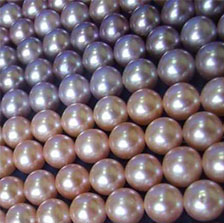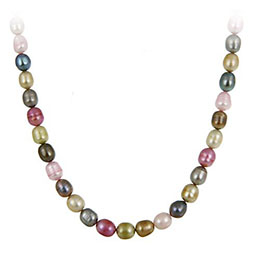Here are the best pairings:Pearls and Gems

We offers one of the finest selections of pearls in all colors, pearl shapes and sizes so you might want to browse by Shape or search among our Loose Pearls or Luxury Pearls. Quality natural pearls are rare jewels and the value is the same as other "precious" gemstones and depends on size, shape and quality.
Understanding the Colors of Modern Pearls
Pearls have been worn all over the world and admired for centuries for their beautiful luster. Often the luster and color of cultured pearls is enhanced by a few additional steps taken after they have been harvested to give us the wide array of colors and styles that we are so familiar with. These processes also make the modern pearl more uniform in size, color and shape while also making them very cost effective!
One of the first things typically done to pearls (including most cultured, fresh water and South Sea Pearls) after they have been removed from the Mollusk, is a bleaching process. This will even out any darkened spots or light areas that may be on the surface of the pearl. Once the surface is smooth and even in tone, color may be applied by dying the pearls. This is done very easily and successfully due to the pearls porous surface. The dyes are comprised of organic and chemical material. It is important to note that a dyed pearl’s color may fade with time but the dying process actually helps keep the pearls porous surface more impenetrable from other liquids that can stain their surface such as oils, perfume, and make up.
Finally, pearls may also be subjected to the process of Irradiation, which uses Gamma-Ray Radiation to darken the pearl from its nucleus (core). This often times will give the pearls a resemblance close to that of the much sought after, South Sea Pearl. Not only can the process darken certain pearls, but has been used to enhance the luster (also known as Orient, the display of iridescent colors) on the surface of a pearl. Since pearls are opaque but display such an array of colors in their iridescent luster, they pair beautifully with many of the transparent and translucent semi-precious gemstones. Here are some of the best gemstone beads and pearl pairings:
 Black Pearls: Diamonds, White Topaz, Cat’s Eye Quartz, Ruby
Black Pearls: Diamonds, White Topaz, Cat’s Eye Quartz, Ruby
Grey Pearls: Labradorite, Amethyst, London Blue Topaz
Peacock Pearls: Tanzanite, Aquamarine, Swiss Blue Topaz
Blue Pearls: Rainbow Monnstone,
Green Pearls: Lemon Topaz, Green Tourmilated Quartz, Prehnite
Pink Pearls: Tourmaline, Rhodolite Garnet
Cream Pearls: Rutilated Quartz, and Peruvian Opal, Emerald
White Pearls: Sleeping Beauty Turquoise, Grey Moonstone
Champagne Pearls: Natural Zircon, Smokey Quartz, Pink Topaz Chocolate Pearls: Peach Moonstone
Cranberry Pearls: Rose Quartz, Whiskey Quartz, Pink Opal

Comment (0)